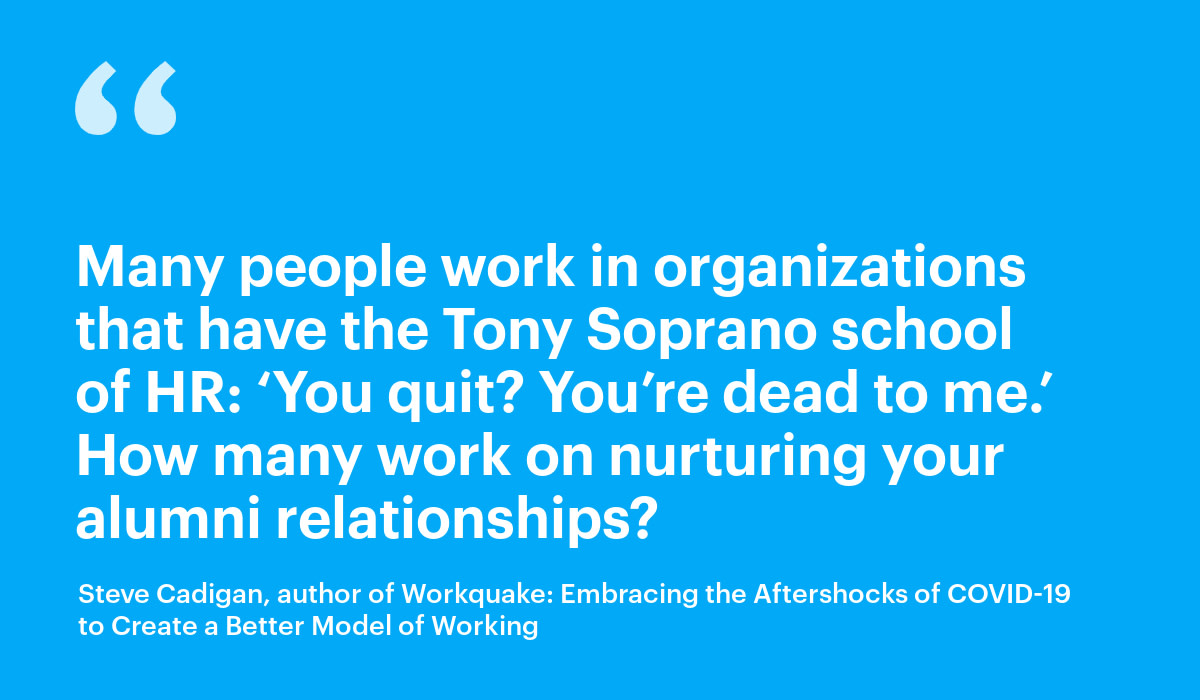Retain, Retrain, Rehire Employees
People analytics doesn’t just improve retention. Find out how to keep the door open to rehire your best rehireable boomerang employees.

Is the solution to high turnover to retain, retrain, or … rehire? In the mid 1990s, average job tenure for men was 4 years (3.5 for women). These days, the average employee will stay at their current position for 2.5 years, which means many people are staying at their companies for even less time.
High turnover costs employers a lot of money. Hiring, training, and the loss of valuable skills led to many companies looking to optimize their talent retention strategies to meet business outcomes. You may already be using people analytics to improve retention, invest in your employee experience, and build a more diverse and inclusive workplace—but sometimes people will leave anyway.
Fortunately, the world is your org chart, goodbye is not forever, and even after employees quit or are laid off, people analytics still has a powerful role to play.
People analytics improves employee retention—to a point
The 2021 Bureau of Labor Statistics reported the overall turnover rate at 57.3%. It’s unavoidable: many of the people working at your organization today will not be working there a few years or even months from now.
Even after the pandemic began to recede, workers kept leaving, and many are not coming back to work. In February, more than half of the 4.4 million Americans who left their jobs went to another occupation or line of work. Many went on to start their own businesses rather than work for someone else. This reduced labor pool of potential employees made many businesses invest in people analytics to target retention. This does help. But even with those employees who do give two weeks’ notice, it’s not necessarily the end.
The skills game of rehiring and retention
Improving retention has value, but the other side of preparing for turnover is building stronger relationships with current employees. This doesn’t just improve loyalty and engagement to improve retention, it also leaves a door open for rehireable employees.

“Organizations that choose change by putting their people first and building a culture of trust and transparency will come out on top,” said Dan Riley, co-founder of Radicl.
In 2021, a Visier report found that 27% of all external hires had a resignation event at the same company within the past three years. These “boomerang” employees prove that even after a person resigns, there’s a chance goodbye is not forever.
While some employees leave because of dissatisfaction with their current pay levels, many find new positions to pursue new skills. However, they often command higher salaries when they come back. Our data shows that ‘boomerang employees’ earned more when rehired at a former employer.
Balking at the idea of a pay increase? Train the people you have now. Cross-skilling and upskilling your people doesn’t just improve employee satisfaction by keeping people engaged and building their careers, it also can also reduce talent acquisition costs by creating the employee you need from within your current employee base. A known strategy is ensuring that your organization’s learning and development and career progression programs meet the needs of your employees. Start by assessing what skills employees are developing within your organization.
Keep the door open for rehireable employees
Lattice recently made the news by offering its employees $100,000 if they quit and start their own company. While this “too good to be true” offer does have strings attached (Lattice is entitled to earnings from the new company), it does highlight a truth many of us like to ignore: even the best employee will move on. Change is constant.

“Many people work in organizations that have the Tony Soprano school of HR: ‘You quit? You’re dead to me.’ How many work on nurturing your alumni relationships?” Steve Cadigan, author of Workquake: Embracing the Aftershocks of COVID-19 to Create a Better Model of Working
But this also means that drivers of resignations also change. If an employee left to go back to school or care for family members, they may be ready to return to work in a few years. If they left because of difficult managers or lack of growth opportunities, the difficult managers may have moved on, and organizational growth opened new positions. When a superstar employee leaves, having a people analytics platform makes it easier to remember your high performing alumni and rehire them for new positions down the road.
Help employees want to stay
Smart organizations focus on increasing employee engagement as a pillar of improving retention numbers. Combining survey data with exit data reveals drivers of voluntary turnover and workforce analytics will help uncover why employees are resigning.
But even with the best company, people have lives outside of work and sometimes economic decisions force companies to reduce headcount. Creating an inclusive workplace that meets the needs of its employees (and avoiding blanket layoffs if necessary to reduce headcount) is the best bet of creating an organization that former employees might want to be rehired at.
During the pandemic, government contractor NCI worked very carefully with their employees to make sure that they were comfortable, that their needs were met, and that they were protected. “We listened to what our employees were experiencing and asked what are the resources and tools that they needed,” said Clay Worley, CHRO of NCI. “This has had a tremendous payoff both in terms of employee loyalty and we’ve continued to see our voluntary turnover drop dramatically during the pandemic.”
The world is your org chart
The pandemic forced many organizations to pivot to working remotely, and the world is not going back. Your ideal employee could be anywhere. The world is much smaller now. This means talent acquisition teams have a much larger pool to work from, and that competition is that much fiercer.
A bad reputation can take years to overcome. A company may judge a former employee as “rehirable,” but the employee may not feel the same way about the company. Organizations that treat their employees well, that invest in DEIB, and that respect the human truth of their employees will find it easier to rehire boomerang employees—and to keep the ones they already have.
Interested in learning more about how people analytics can help find rehirable employees? Schedule a demo today.


